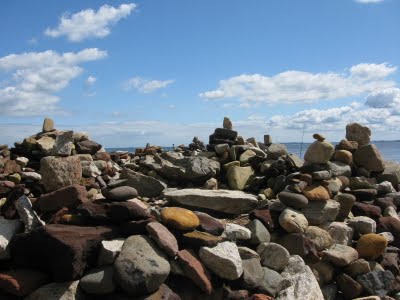“I do not think I can write more…For Gods sake look after our people,” wrote Robert Falcon Scott on March 29, 1912. These were the final words he wrote in his journal. At the time he was in a small tent, that he, Dr. Edward Wilson and Lt. Henry Bowers had erected 10 days earlier. They were the final three men left from Scott’s team of five, which had reached the South Pole on January 17.
No one would discover the tent and the frozen bodies until November 12, when surgeon Edward Leicester Atkinson and a search party located the site. Atkinson wrote of their discovery “It was an object partially snowed up and looking like a cairn. Before it were the ski sticks and in front of them a bamboo which was probably the mast of the sledge.” The tent was a quarter of a mile from another cairn and about eleven miles from a food cache known as One Ton Depot.
 After thoroughly searching the tent, the men, and the surroundings, during which Atkinson’s party located “35 lbs. of very important geological specimens,” the searchers built a “mighty cairn.” They finished the commemorative ice structure the next day. Atop it rose a rough cross, made from skis, and nearby stood two sledges. Within a metal cylinder, Atkinson left the following record:
After thoroughly searching the tent, the men, and the surroundings, during which Atkinson’s party located “35 lbs. of very important geological specimens,” the searchers built a “mighty cairn.” They finished the commemorative ice structure the next day. Atop it rose a rough cross, made from skis, and nearby stood two sledges. Within a metal cylinder, Atkinson left the following record:
‘November 12, 1912, Lat. 79 degrees, 50 mins. South. This cross and cairn are erected over the bodies of Captain Scott, C.V.O., R.N., Doctor E. A. Wilson, M.B. B.C., Cantab., and Lieutenant H. R. Bowers, Royal Indian Marine—a slight token to perpetuate their successful and gallant attempt to reach the Pole. This they did on January 17, 1912, after the Norwegian Expedition had already done so. Inclement weather with lack of fuel was the cause of their death. Also to commemorate their two gallant comrades, Captain L. E. G. Oates of the Inniskilling Dragoons, who walked to his death in a blizzard to save his comrades about eighteen miles south of this position; also of Seaman Edgar Evans, who died at the foot of the Beardmore Glacier. ‘”The Lord gave and the Lord taketh away; blessed be the name of the Lord.”‘
In the century since Scott, Wilson, and Bowers died, their bodies have slowly moved away from their point of death. According to an article by R.K. Headland in the July 2011 Polar Record, the tent was located on about 360 feet of ice on the Ross Ice Shelf. Based on ice movement measurements, the tent and ice cairn have traveled about 37 miles from their original location. They are also buried under 53 feet of ice. Headland further calculated that the bodies will reach the edge of the ice front in another 248 years or so, buried by more than 325 feet of ice, which will put them below sea level.
The bodies will not, however, then just pop out of the ice into the water. Headland writes that they most likely will be “carried off within an iceberg when they get close enough to the ice front.” Ice currents, the iceberg’s size and how it melts will ultimately determine the fate of the men and the cairn. I am guessing by that time, the cairn will be one of, if not, the best traveled cairn in history.
